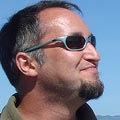Planes and Lines in Against the Day, by Thomas Pynchon
Against the Day is organized like A Thousand Plateaus by Gilles Deleuze and Felix Guattari. It is constructed of planes and surfaces, each a continuum of either space or time. These planes intersect, as do the novel's subplots and concepts, through a series of dots or plot points connected by narrative arcs, each a line of flight, each borne on the wing and whimsy of Pynchon's mad characters and historical doubles, and drawn by the invisible hand of an agency whose intrinsic logic is algorithmic, artistic, atomist, ballistic, bled, blown, buried, chemical, conjured, counter-transferred, detonated, differential, disappearing, dug, energized, explosive, forensic, forlorn, found, hallucinated, harmonized, illuminating, impregnated, internalized, literary, lived, logarithmic, lost, loved, melodic, modal, orphaned, passional, painted, played, plotted, political, projected, probabilistic, pursued, pursuing, quantum, recollecting, reflecting, refracting, scientific, screened, screwed, shuffled, spun, strummed, strung, subjective, telegraphed, transferred, vector-based, wired, wirelessly transmitted, or blown by trade wind or un-ticketed time-travel (the two primary modes, and two shadows produced on the book's jacket cover). Each of Thomas Pynchon's works has featured both structures favoring death and the lines of flight that escape them, for he recognizes that a structure is defined by that which escapes it. This book is nothing less than the production and reproduction of subjectivity itself--which is an organization of perceptions, affects, and actions. For Pynchon, I believe, subjectivity emerges within the given, not outside it. The deeply Spinozist and Bergsonian ground on which this narrative unfolds provides opportunity for the synthesis of space and time, in the subjective mind, on the basis of images and transformations. Light, here, is connected with matter, and Einstein's theory of relativity is set against the atomist's and empiricist's conviction that the real is concrete. Either space and matter, or time, provide the rule of transformation for any particular line of flight and plane or surface of narrative and event. Points are connected either by the travels of balloonists in space, or time travelers. They meet in a strangely doubled (bi-located) and refracted four dimensional world. The key to live, or death, is in the hands of competing forces seeking to unlock time, light, or matter, each of which are distributed according to a co-ordinal logic of number-location or a logic of movement-time. Whether those who travel by location/position or those who travel by history/time will win remains to be seen, as I'm only half way through. Happy trails fellow readers!
These series will be developed further at our Pynchon blog
books, book reviews, pynchon, thomas pynchonLabels: against the day, analysis, blog, review, thomas pynchon
These series will be developed further at our Pynchon blog
books, book reviews, pynchon, thomas pynchon
Labels: against the day, analysis, blog, review, thomas pynchon


<< Home